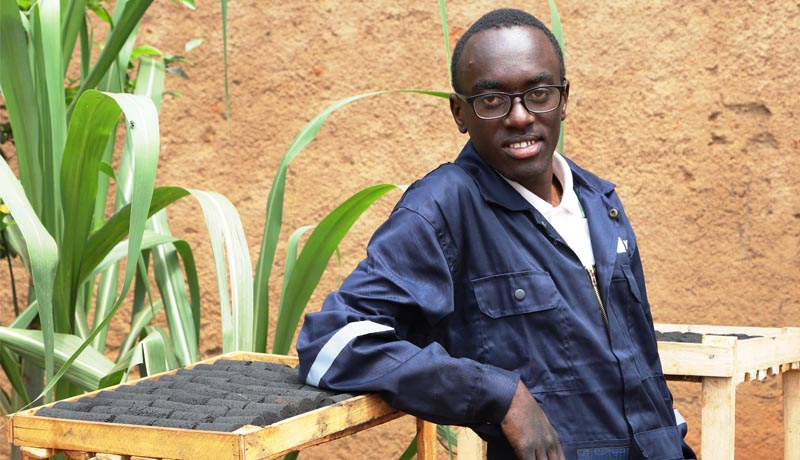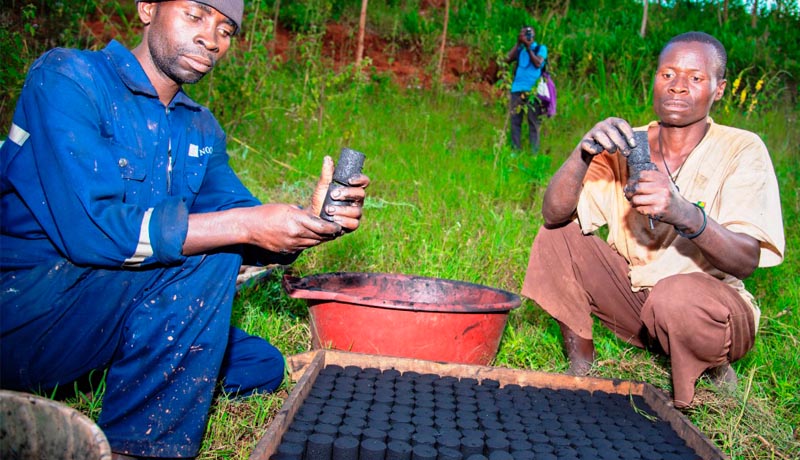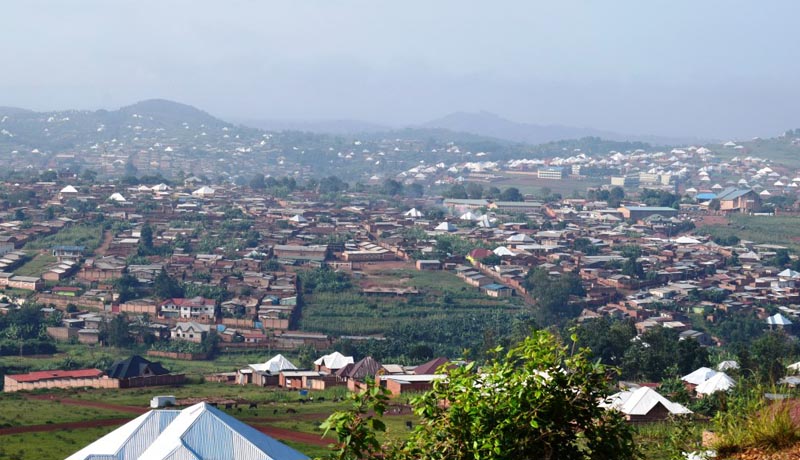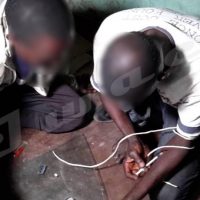Delphin Kaze, 23, a young man from Gitega, Burundi’s second-largest city, located in the Nile basin, has found an alternative to preserve the trees. He makes ecological charcoal from maize stalks. In Burundi, wood is the primary source of domestic energy, with 96.6% of the overall energy balance.
By Rénovat NDABASHINZE, translated into English by Pierre Emmanuel Ngendakumana

Delphin Kaze, initiator of the project
Gitega, the new political capital of Burundi is located at 102 kilometers from Bujumbura (the economic capital), in the center of the country. It is a city in the middle of the central plateau area. Concerned about the pace of deforestation in the country, Delphin Kaze, a recent university graduate, started producing an eco-friendly version of charcoal, mainly from corn stalks and other biodegradable waste.
His small business, called Kaze Green Economy (KAGE), is located in Karera II quarter, close to the marshes. From far away, it looks like a small tented house with banners.
“Production is intense in March, April, and May. Indeed, this is the great post-harvest period for maize throughout the country,” said Delphin Kaze, the project’s founder.
Finding ways to counter the high rate of deforestation in the country was the trigger for this young graduate from the Polytechnic University of Gitega, in the Faculty of Environmental Sciences, Department of Climate and Biodiversity. The country’s entire forest cover is at risk of being wholly obliterated in as few 25 years, mainly due to increasing rates of consumption of charcoal, which is made from cutting down trees. “I came up with the idea in 2017 when I was researching to address the problems of deforestation. The main cause was the search for firewood and charcoal,” Kaze said.
Flourish Slider to show deforestation:
In the beginning, Kaze attempted to make briquettes from biodegradable waste. The result was not entirely satisfactory. The young man returned to the libraries to find a better product. An idea dawned on him: “Some low-income families use corn cobs as fuel. So I thought, what if we improve this product?” he said. He decided to add another product to his raw material: corn cobs. Finally, his product was validated by the Ministry of Higher Education and Scientific Research. The adventure began in 2018. To succeed, Delphin joined forces with other young people. Among them, there was a Bachelor’s degree holder in Public Health, another young woman with a Bachelor’s degree in Water, Pollution, and Sanitation, and three others without university qualifications. His team now consists of six young people.
Promotion of the green economy

Coal made from corn cobs
“My goal is to produce clean, cheaper and sustainable coal,” Kaze said. Manufacturing at Kaze Green Economy follows a process. First, the team collects maize stalks from households, dumps, and other such areas. Then comes the drying process. “All moisture must be removed before the first stage of manufacturing called pyrolysis.” The raw material is then put into an oven. “This is where the fire is set so that at the end, you get a blackish colored corn stalk,” Kaze explains. “At this stage,” he continues, “they are rich in carbon.”
Then comes the crushing stage to get powder. “It is this powder that is mixed with other products to make organic charcoal,” the young entrepreneur said. As in the beginning, this coal is filled with little moisture. “We still do the drying to get a product ready to use.”
Called Kabiof Charcoal, it’s odorless coal that doesn’t emit smoke. It means, Kaze explained, that unlike wooden charcoal, even the health of the users is preserved. Not toxic, this ecological charcoal also does not blacken kitchen utensils, and a single piece can be used for more than two hours. “Its low price and ability to be reused save money,” Kaze said. The price of 1 kilogram is BIF 300 ($0.16). And only eight pieces of his coals are enough to cook beans.
The customers of KAGE confirm it. “This is really an excellent innovation,” said Isidore, a father living in Magarama locality, in Gitega center. “At the time, I was spending BIF 2000 ($1.06) per day to purchase charcoal. But now I only need BIF 600 ($0.32) to cook all the food for the day.” Switching to the eco-coals allowed him to recover 70 percent of his spendings on cooking fuel that he can now use for other expenses.
As far as health is concerned, Isidore did not doubt that ecological coal has advantages. “Charcoal gives off smoke. And the pots turn black. But this new product is different: No smoke,” he said. This man also saw the innovation as a way to help make the city clean by ridding it of excess corn stalks. “During the corn harvest, the stalks were hard to manage. But now it has become the raw material for a very beneficial product.”
Another customer, a woman named Annonciate, found the ecological coal was also a way to protect the trees. “To find firewood or charcoal, we resort to cutting down trees. It amplifies deforestation. But this company doesn’t have to cut down trees to get that solid fuel,” the Gitega people said. She only asked that the company increase its production because she said that production disruptions were frequent on the market.
With six employees, the company now produces between 300 and 400 kilograms of coal per day. M.Kaze recognizes that his production is still low because the town of Gitega consumes 260 tonnes of coal weekly. But, for founder Delphin Kaze, this is a good step forward. ‘’At the beginning, production ranged only between 30 and 40 kilograms per day,” he said.
Now, Kaze’s company is only able to provide for about 1% of the city’s demand. But he hoped that with the arrival of modern machinery and access to electricity, his company would be able to increase production to satisfy the entire demand of the Burundian market ultimately. “We plan to install units in other cities like Bujumbura to reduce charcoal consumption significantly,” Kaze said.
This young entrepreneur announced that his mission was to raise awareness of the use of renewable energy. “It also means improving access to clean energy for vulnerable populations while ridding cities of organic waste and avoiding the destruction of our forests,” he added.

Partial view of the town of Gitega
Gitega: second only to Bujumbura in charcoal consumption
The Woods and Tropical Forests report produced in 2016 by High Teachers’ Training School (ENS), and University of Burundi (UB) shows that in Burundi; wood is the primary source of domestic energy, making up 96.6% of raw material for domestic energy use. Cities consume the highest amount, with 77% of the country’s total consumption of charcoal being used in urban areas.
According to the report, 56,548 tonnes and 13,552 tonnes of charcoal were consumed by the urban populations of Bujumbura and Gitega, respectively, in 2016. It is a total of 70 thousand tonnes consumed in the two cities alone, about 67 percent of the country’s entire consumption in urban areas.
For these two cities, charcoal consumption leads to an annual loss of 3,505 to 4,673 hectares of forest cover. With country-wide forest estimated at 171,625 hectares, this amounts to almost 3 percent of Burundi’s entire forest cover being destroyed every year due to charcoal consumption in Gitega and Bujumbura alone.
Charcoal use has skyrocketed in recent decades: In 2003, Gitega consumed only 428 tonnes. But by 2016, the study showed that Gitega was already consuming 260 tons per week.
At this rate, said Tharcisse Ndayizeye, an environmental expert, Burundi’s entire forest cover could disappear after just 25 to 33 years. Thus, he appreciated Delphin Kaze’s idea as a strategy to fight this destructive trend while still providing affordable energy to the Burundian population. “It is urgent to preserve our forests. And that means making substitutes for charcoal and finding other domestic solid fuels,” Ndayizeye said.
An official from the Ministry of the Environment, Agriculture, and Livestock similarly applauded the innovation. Emmanuel Ndorimana, his Permanent Secretary, encouraged all the people to go forward with initiatives to decrease deforestation. “This is the best way to protect trees because the majority of the people go to the forests to be able to cook,” he said.
At a time when waste management is a problem, Ndorimana appreciated that Delphin Kaze’s project also helps to keep the city clean.
What is Gitega?
Gitega (formerly Kitega) is the second-largest city in Burundi. Currently designated the political capital of the country, it is located in the center of the country, 102 kilometers from Bujumbura. It has more than 130,000 inhabitants with a density of more than 4 thousand inhabitants per square mile. This former capital until 1962 currently has an area of 27.8 square kilometers. The altitude is 1,504 meters.
This story was supported by InfoNile with funding from the National Geographic Society.
















 IWACU Open Data
IWACU Open Data

